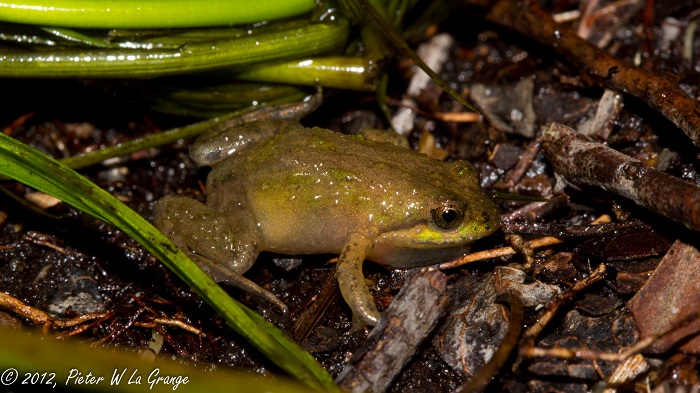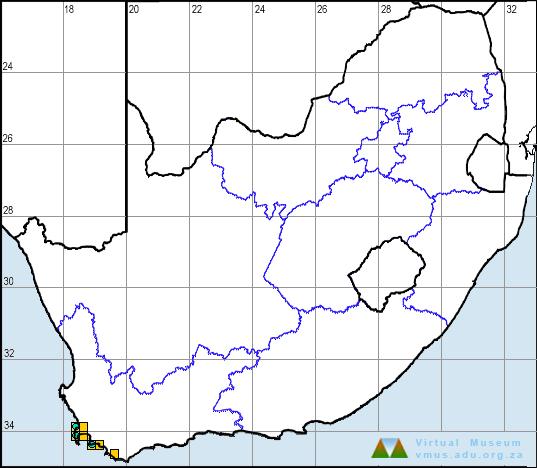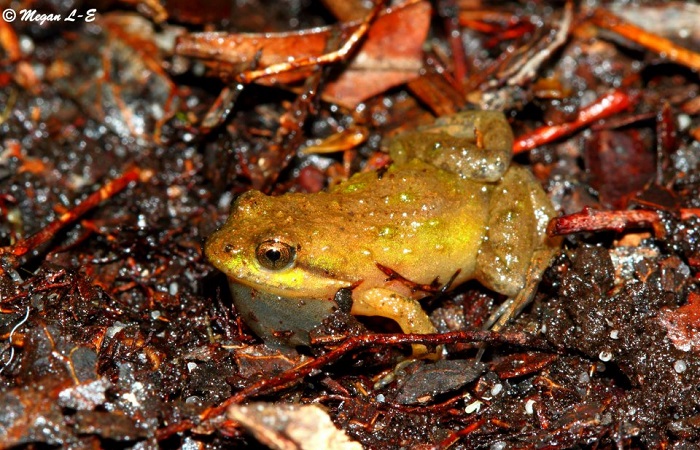Cover photo by Megan Loftie-Eaton.
Find the Micro Frog in the FBIS database (Freshwater Biodiversity Information System) here.
Family Pyxicephalidae
Identification
The Micro Frog is one of the smallest amphibians in southern Africa, attaining a length of only c.18 mm. The pupil is horizontally elliptical. The toes are partially webbed, with 2–3 phalanges of the longest toe free of webbing. The dorsum generally has a variable green, brown and/or grey colour, usually interspersed with darker shading and markings. A thin vertebral stripe is often present, sometimes flanked by broader lateral stripes. The ventrum is smooth and off-white or with variable black and white mottling. The throat area of males is plain brown without mottling. The length of the shank is less than half the body length. The call is a series of low-pitched scratches emitted at a rate of about one per second (Passmore and Carruthers 1995).
Although M. capensis belongs to a monotypic genus, it is of similar size and appearance to the sympatric species Cacosternum platys. C. platys can be distinguished from M. capensis by its somewhat flatter appearance (with limbs extended more laterally), a lack of webbing between the toes, a predominantly white underside with small, discrete dark spots, and its distinctly different call (Rose 1962; Channing 2001).
Habitat
The Micro Frog has specialised habitat requirements and is sensitive to urban and agricultural threats and invasive plants, and animals. The species is restricted to certain wetlands in low-lying coastal areas of the Fynbos Biome, where fynbos plant communities, typically dominated by restios and/or sedges, occur on neutral to acid sands. The relevant vegetation types are Mountain Fynbos, Sand Plain Fynbos, Mountain Fynbos mixed with Limestone Fynbos in the Gansbaai/Agulhas region, and Mountain Fynbos interspersed with elements of Dune Thicket in parts of the Kleinmond area.
The wetlands comprise ponds, pans, vleis and coastal lakelets filled with darkly stained, humic, generally acidic waters (pH 4.0–7.0). Most of these wetlands are seasonal, and by late summer most breeding sites are dry. Some of the larger wetlands (<25%) at times still retain some water by the end of the dry season, and a few never seem to dry up. The wetland substrates tend to contain a dark humic layer, and the sandy surroundings vary from white to grey to almost black, depending on the humic content.
Although the Micro Frog appears to be intolerant of habitat modification, a few of the breeding sites (c.15%) are situated in previously excavated areas where natural vegetation has recovered sufficiently and water quality meets the necessary requirements (pers. obs.).
Behaviour
The Micro Frog is a winter breeder and commences breeding once the rains have filled its seasonal wetland habitat. Breeding activity has been recorded as early as May (Visser 1979a) and as late as October (pers. obs.), but the prime breeding season is July–September. It is a relatively vocal species and is known to call in high densities. The calls can be heard both day and night, but calling activity is generally more intense at night. At prime breeding sites under ideal conditions, choruses of hundreds of individuals can be heard. Males call from emergent vegetation (e.g., restios) at water level, and from floating vegetation.
The eggs are attached to submerged vegetation in clusters of c.20. Each individual egg is enclosed in a jelly capsule. The tadpoles are benthic and relatively large. Larval development is fairly slow and its duration is believed to depend on factors such as tadpole population density, food and water availability, and temperature. Rose (1929) recorded the emergence of newly metamorphosed froglets in early December. These are only slightly smaller than the adults.
When their wetland habitat starts to dry up, these frogs bury themselves and aestivate through the dry season. Rose (1929) unearthed specimens on the site of a dry seasonal vlei, and about 20 were seen emerging from cracks in damp wetland substrate with the onset of early winter rains (pers. obs.).

Near Cape Town, South Africa
Photo by Pieter La Grange
Status and Conservation
Status
The Micro Frog is southern Africa’s most threatened lowland amphibian. More than 80% of its habitat has been lost. Previously listed as Rare (Mclachlan 1978) and Endangered (Branch 1988), the species is now classified as Critically Endangered (Harrison et al. 2001; this publication). The criteria are a severely fragmented area of occupancy <10 km2 (four subpopulations sensu IUCN Criteria), and a projected decline in the extent of occurrence, area of occupancy, quality of habitat, and number of locations, subpopulations and mature individuals. The species is legally protected by the Nature Conservation Ordinance 19 of 1974, but is not listed by CITES.
Despite its Critically Endangered status, the species occurs in relatively high population densities with an estimated 1000 adults occupying an area of 50 × 50 m of prime breeding habitat. At present, <25% of M. capensis breeding habitat is conserved in Kleinmond Coastal and Mountain Nature Reserve (local authority), Groot Hagelkraal Private Nature Reserve (between Gansbaai and Agulhas) and Greater Betty’s Bay Nature Reserve (local authority). Furthermore, the residential area of Betty’s Bay poses a threat to most of the remaining M. capensis habitat in Greater Betty’s Bay Nature Reserve.
Threats
All four subpopulations (sensu IUCN Criteria) and most breeding sites are threatened to a varying degree by human interference. In particular, urban and rural development (including agriculture and associated threats) have caused considerable habitat degradation and loss.
Specific threats include the filling in of habitat; alteration of the water table and drainage patterns that cause either drainage or possible flooding of breeding sites; establishment of sand mines that are a threat to populations in the Kleinmond area (De Villiers 1997b); siltation, pollution and eutrophication of wetland habitat; spread of invasive alien vegetation at a number of localities, especially in the form of Port Jackson Willow Acacia saligna stands; and, potentially, fynbos flower-farming activities.
Invasive alien vegetation not only eliminates fynbos vegetation and reduces the water resources of wetlands, but also results in deterioration in the quality of habitat through changes in water chemistry. Although fire plays an important role in fynbos ecosystems, an increase in the incidence of fire can have a detrimental effect on frog populations.
At some localities (e.g., the Groot Vleie at Betty’s Bay), Bulrushes Typha capensis and reeds Phragmites australis have invaded M. capensis habitat. Reasons for this include eutrophication, the build up of sediment (e.g., through water being channelled into wetlands and the decomposition of excessive plant growth), and a constantly high water table.
Recommended conservation actions
The distribution and conservation status of M. capensis is monitored by the Western Cape Nature Conservation Board (WCNCB; De Villiers 1997a) as part of a threatened species monitoring programme. Breeding sites are monitored annually. A research project is being undertaken to investigate the genetic relationships of the four subpopulations (sensu IUCN Criteria). This will help determine priorities with regard to the conservation and management of these subpopulations.
Management of the Micro Frog’s habitat is an important responsibility and needs to be improved at most breeding sites, especially those on unprotected, privately owned land. The main management activity involves the control of alien vegetation. Structures responsible for the management of populations are as follows: the Cape Flats subpopulation by WCNCB; Betty’s Bay subpopulation by Overstrand Municipality; Kleinmond Coastal and Mountain Nature Reserve by Overstrand Municipality; the remaining breeding sites of the Kleinmond subpopulation, all situated on unprotected private land, by WCNCB with regard to alien vegetation control; and Groot Hagelkraal Private Nature Reserve by Eskom. The remaining breeding sites of the Gansbaai to Agulhas subpopulation are all situated on unprotected private land where there is, as yet, no proper management programme.
At present, <25% of M. capensis habitat is conserved and additional nature reserves are urgently needed. Lack of funding is a major problem in this regard. In general, the Critically Endangered status of M. capensis needs to be publicized to attract public support for conservation of the species.
Sand-mining operations in the vicinity of M. capensis localities must be stopped and the affected habitat rehabilitated (De Villiers 1997b), but legal difficulties and a lack of funding have hampered progress in this regard.
As the distribution of the Micro Frog on the Cape Flats is restricted to <10 ha of wetland habitat on unprotected private property at Kenilworth Race Course, a translocation experiment was undertaken in September 1999. This involved the translocation of c.140 M. capensis tadpoles from the Kenilworth population to a protected blackwater wetland in Rondevlei Nature Reserve, 7 km away. The species has not previously been recorded from this nature reserve, but the nearest historical record, Princess Vlei, is 2 km away. At the time of writing, this experiment did not appear to have been successful but requires further investigation. A captive breeding programme for M. capensis is not recommended.
Finally, it is imperative that wetlands supporting populations of this species should not be stocked with predatory alien fish.
Distribution
The Micro Frog is endemic to the atlas region and is restricted to the winter-rainfall region of the Western Cape Province. Based on both previous and current records, this spans a distance of c.140 km from the Cape Flats southeastward to the Agulhas region. Distribution records are further limited to low-lying areas of 10–80 m a.s.l. within 10 km of the coast in areas with an annual rainfall of >500 mm.
M. capensis was first discovered on the Cape Flats. The species was described in 1910 and, for a period of 65 years thereafter, the Cape Flats was the species’ only known area of distribution (De Villiers 1988a). Although the discovery and description of the species was based on only one specimen (Boulenger 1910), the frog was later reported to have a wide distribution on the Cape Flats (Rose 1929). All recorded Cape Flats localities fall within an area of <100 km2 on the western half of the Cape Flats (3318CD, DC; 3418AB, BA). These include Crawford, Lansdowne, Kenilworth Race Course, Princess Vlei, Retreat, Ottery and Varkensvlei. No confirmed records were ever obtained from the Cape Peninsula (De Villiers 1988a).

The Micro Frog was first reported as being threatened by Rose (1962), who stated that the species had become “something of a rarity” on the Cape Flats as a result of “fencing, building, draining”, and “contaminating”. Following this, no further specimens were found for c.10 years from the mid-1960s on, and it was feared that the species was extinct.
In the period 1975–80, an amphibian survey by the then Cape Department of Nature and Environmental Conservation (carried out by J.C. Greig, R.C. Boycott, A.L. de Villiers) resulted in the discovery of three additional populations: along the coastal forelands to the southeast of the Cape Flats at Betty’s Bay (3418BD) in 1975, Kleinmond (3419AC) in 1976, and midway between Gansbaai and Agulhas (3419DA) in 1980.
During the period 1988–90, a survey was undertaken by the then Cape Chief Directorate Nature and Environmental Conservation (carried out by the author) to examine the distribution, habitat requirements and conservation status of M. capensis. Coincidentally, in August 1988, a botanical survey of the Cape Flats by C.R. McDowell led to the discovery of a healthy M. capensis population in undisturbed wetlands at Kenilworth Race Course (McDowell 1989). This was the first time the species had been seen on the Cape Flats in c.23 years. Furthermore, this appears to be the only remaining Cape Flats population. The frog survey confirmed the presence of this and the other three previously discovered populations to the east, but no additional populations were discovered. In total, 26 breeding sites were recorded, 14 of which were new localities. Since then, despite the destruction and degradation of habitat (e.g. De Villiers 1997b), there has been no significant change in the distribution of M. capensis. Breeding sites are monitored annually (De Villiers 1997a).
In summary, M. capensis has been recorded from a total of seven quarter-degree grid cells, in four subpopulations (sensu IUCN Criteria), namely the Cape Flats (four grid cells), Betty’s Bay, Kleinmond, and Gansbaai/Agulhas subpopulations. At present the species still occurs in four subpopulations, but its total area of occupancy is <10 km2 situated in four grid cells, that is, one grid cell for each subpopulation.
The atlas data are reliable and complete.
Addendum: 20 October 2025
A new subpopulation of Microbatrachella capensis was found in 2021 in the Nuwejaars Wetlands Special Management Area on the Agulhas Plain. This has become the 5th known subpopulation of Microbatrachella capensis and appears to constitute both the most inland and the most easterly known subpopulation. Due to the Nuwejaars Wetland’s size and protected status, this may prove to be a stronghold for this critically endangered frog species.
A link to the Nuwejaars Wetland website and corresponding Micro Frog article can be found here.
Further Resources
The use of photographs by Megan Loftie-Eaton and Pieter La Grange is acknowledged.
Micro Frog Microbatrachella capensis (Boulenger, 1910)
Other Common Names: Mikropadda (Afrikaans)
Recommended citation format: de Villiers, AL; Tippett, RM. (2025). Micro Frog Microbatrachella capensis. Biodiversity and Development Institute, Cape Town. Available online at https://thebdi.org/2022/02/20/micro-frog-microbatrachella-capensis/
This species text has been updated and expanded from the text in the
2004 frog atlas: de Villiers, AL. (2004). Micro Frog Microbatrachella capensis. In Minter LR et al 2004.
References:
Minter, LR; Burger, M; Harrison, JA; Braack, HH; Bishop, PJ; Kloepfer, D. (Editors). (2004). Atlas and Red Data Book of the Frogs of South Africa, Lesotho and Swaziland. Smithsonian Institution, Washington, and Avian Demography
Unit, Cape Town.
Carruthers, V; du Preez, L. (2017). Frogs of southern Africa: A Complete Guide. Struik Nature, Cape Town.
Channing, A. (2001) Amphibians of Central and Southern Africa. Protea Book House, Pretoria

